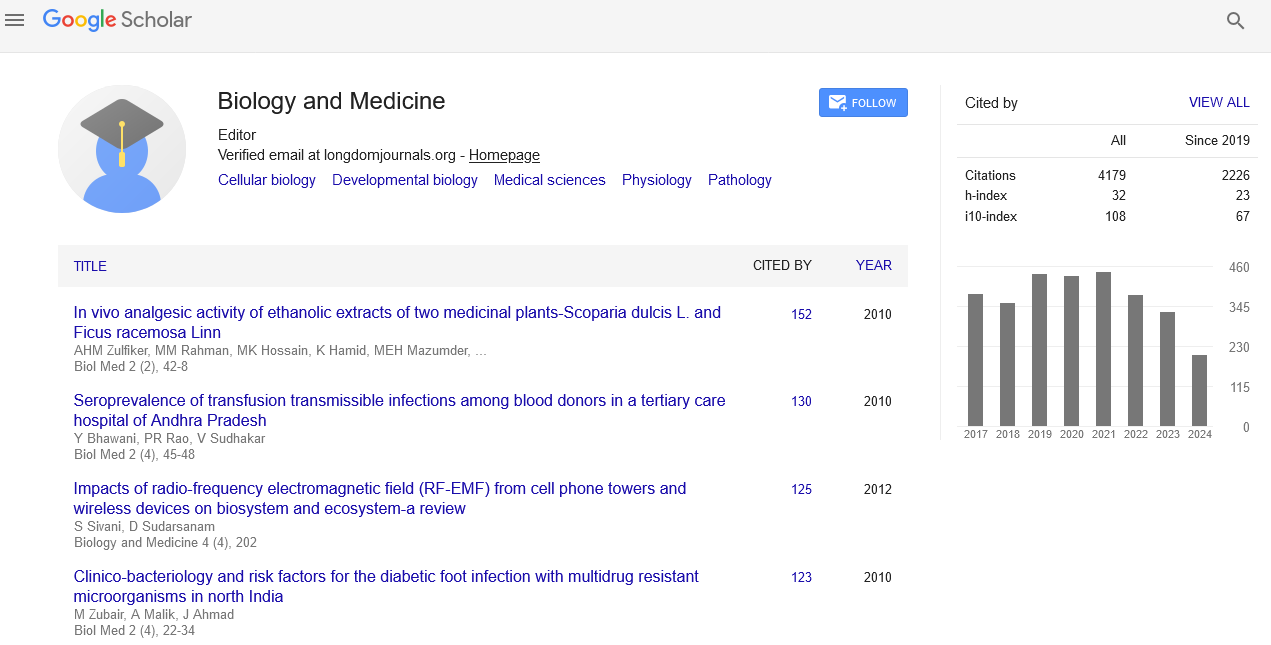Indexed In
- Open J Gate
- Genamics JournalSeek
- CiteFactor
- Cosmos IF
- Scimago
- Ulrich's Periodicals Directory
- Electronic Journals Library
- RefSeek
- Hamdard University
- EBSCO A-Z
- Directory of Abstract Indexing for Journals
- OCLC- WorldCat
- Proquest Summons
- Scholarsteer
- ROAD
- Virtual Library of Biology (vifabio)
- Publons
- Geneva Foundation for Medical Education and Research
- Google Scholar
Useful Links
Share This Page
Journal Flyer

Open Access Journals
- Agri and Aquaculture
- Biochemistry
- Bioinformatics & Systems Biology
- Business & Management
- Chemistry
- Clinical Sciences
- Engineering
- Food & Nutrition
- General Science
- Genetics & Molecular Biology
- Immunology & Microbiology
- Medical Sciences
- Neuroscience & Psychology
- Nursing & Health Care
- Pharmaceutical Sciences
Short Communication - (2025) Volume 17, Issue 5
The Rise of 3D Bioprinting: Revolutionizing Tissue Engineering
Olivia Wang*Received: 12-Feb-2025, Manuscript No. BLM-25-28800; Editor assigned: 14-Feb-2025, Pre QC No. BLM-25-28800 (PQ); Reviewed: 28-Feb-2025, QC No. BLM-25-28800; Revised: 07-Mar-2025, Manuscript No. BLM-25-28800 (R); Published: 14-Mar-2025, DOI: 10.35248/0974-8369.25.17.772
Description
The field of bioprinting has witnessed a remarkable transformation over the past decade, with 3D printing technologies pushing the boundaries of what is possible in the realm of tissue engineering and regenerative medicine. Bioprinting, the process of printing living cells into three-dimensional structures, holds the potential to create functional human tissues and even organs. The promises of 3D bioprinting are vast, including breakthroughs in organ transplantation, drug testing, and personalized medicine.
However, while the potential benefits of 3D bioprinting in medicine are undeniable, it is crucial to acknowledge the challenges and ethical concerns that accompany its rapid development. This opinion piece aims to explore both the exciting prospects and the obstacles facing the integration of bioprinting into clinical practice.
One of the most significant applications of 3D bioprinting is in the field of tissue regeneration. By using bioinks that consist of living cells, growth factors, and other biomaterials, 3D bioprinting can create structures that closely mimic the architecture of human tissues. These bioprinted tissues can be used to repair or replace damaged tissues, offering a potential solution to conditions such as skin wounds, cartilage damage, and bone fractures.
Moreover, 3D bioprinting allows for the customization of tissue constructs based on the patient’s specific genetic profile, promoting personalized medicine. This could lead to the development of tailored solutions for patients with chronic conditions or injuries, offering a more effective and long-lasting treatment compared to conventional methods.
Perhaps the most exciting promise of 3D bioprinting is its potential to create fully functional human organs for transplantation. The global shortage of donor organs is a major healthcare crisis, with thousands of patients waiting for lifesaving transplants each year. 3D bioprinting could revolutionize organ transplantation by enabling the creation of biocompatible organs from a patient’s own cells, thus reducing the risk of organ rejection and immune system incompatibility.
While the development of fully functional organs, such as livers, hearts, and kidneys, remains a long-term goal, significant strides have been made in creating simpler tissues, such as vascular networks and cartilage, which could lay the foundation for more complex organs in the future. For instance, researchers have already successfully bioprinted functional heart valves and bladders, and work is ongoing to improve the vascularization of larger tissues to ensure their survival and functionality after implantation.
3D bioprinting is also poised to revolutionize the field of drug testing and disease modeling. Traditional drug testing methods often rely on 2D cell cultures or animal models, which do not fully replicate the complexity of human tissues. Bioprinted tissues, on the other hand, provide a more accurate and reliable platform for testing new drugs and therapies in a setting that mimics the human body more closely.
For example, bioprinted liver tissues can be used to test the toxicity of pharmaceutical compounds, while tumor models can be created to test the efficacy of cancer drugs. These advances will not only improve the drug development process but also reduce the need for animal testing, aligning with growing ethical concerns in the scientific community.
Despite the promising advances in 3D bioprinting, significant technical hurdles remain before bioprinted tissues can be widely used in clinical settings. One of the biggest challenges is vascularization — the creation of a network of blood vessels to supply oxygen and nutrients to bioprinted tissues. Without adequate vascularization, bioprinted tissues cannot survive once implanted into the body, limiting their functionality.
Researchers are exploring various approaches to solve this issue, such as printing cells that can form blood vessels or embedding bioprinted tissues within pre-existing vascular networks. However, creating complex and fully functional vascular systems within large bioprinted organs is still an ongoing challenge.
Additionally, achieving the precision and scalability necessary for printing large, complex organs is another obstacle. While current technology has allowed for the bioprinting of relatively small tissues, printing full organs with the necessary level of complexity remains a distant goal.
As with any new medical technology, 3D bioprinting faces significant regulatory challenges. Bioprinted tissues and organs must undergo rigorous testing to ensure their safety and efficacy before they can be used in human patients. This includes addressing issues such as biocompatibility, immune rejection, and the long-term stability of bioprinted materials within the human body.
The regulatory approval process for 3D bioprinted products is still in its early stages, and governments and regulatory bodies around the world will need to develop frameworks to ensure that these technologies are thoroughly vetted before clinical use. Clear guidelines are necessary to protect patients and to facilitate innovation in this rapidly advancing field.
The use of 3D bioprinting in medicine also raises significant ethical dilemmas, particularly with regard to the creation and use of human tissues and organs. One of the most pressing concerns is the potential for bioprinting of human embryos, or the creation of genetically modified tissues that could raise questions about human enhancement or designer organs.
Furthermore, there are concerns about the accessibility of 3D bioprinting technology. While it holds the potential to revolutionize healthcare, the high cost of bioprinting technologies and bioinks may limit access to these treatments, particularly in low-income settings or countries. As bioprinting technologies advance, it will be important to address equity in access to these innovations.
Conclusion
The rise of 3D bioprinting is undoubtedly one of the most exciting developments in tissue engineering and regenerative medicine. Its potential to revolutionize organ transplantation, drug testing, and personalized treatment is immense. However, the technology is not without its challenges, including technical limitations, regulatory hurdles, and ethical concerns that must be addressed to ensure its safe and effective use in clinical applications.
References
- Odgers CL, Jensen MR. Annual research review: Adolescent mental health in the digital age: Facts, fears, and future directions. J Child Psychol Psychiatry. 2020;61(3):336-348. [Crossref] [Google Scholar] [PubMed]
- Small GW, Lee J, Kaufman A, Jalil J, Siddarth P, Gaddipati H, et al. Brain health consequences of digital technology use. Dialogues Clin Neurosci. 2022. [Crossref] [Google Scholar] [PubMed]
- Yılmaz D, Yıldız M. Analysis of the mobile phone effect on the heart rate variability by using the largest lyapunov exponent. J Med Syst. 2010;34(6):1097. [Crossref] [Google Scholar] [PubMed]
- Andrzejak R, Poreba R, Poreba M, Derkacz A, Skalik R, Gac P, et al. The influence of the call with a mobile phone on heart rate variability parameters in healthy volunteers. Ind Health. 2008;46(4):409-417. [Crossref] [Google Scholar] [PubMed]
- Saini BS, Pandey A. Effect of mobile phone and BTS radiation on heart rate variability. IJRET. 2013;2:662-666. [Google Scholar]
- Dogra AK, Saini I, Sood N. Impact of wireless cellular network on heart rate variability. In 2020 International Conference on Computational Intelligence for Smart Power System and Sustainable Energy. 2020;1-4. [Crossref] [Google Scholar]
- Alassiri M, Alanazi A, Aldera H, Alqahtani SA, Alraddadi AS, Alberreet MS, et al. Exposure to cell phones reduces heart rate variability in both normal-weight and obese normotensive medical students. Explore. 2020;16(4):264-270. [Crossref] [Google Scholar] [PubMed]
- Ahamed VT, Karthick NG, Joseph PK. Effect of mobile phone radiation on heart rate variability. Comput Biol Med. 2008;38(6):709-12. [Crossref] [Google Scholar] [PubMed]
- Parazzini M, Ravazzani P, Tognola G, Thuróczy G, Molnar FB, Sacchettini A, et al. Electromagnetic fields produced by GSM cellular phones and heart rate variability. J Bio Electro Magnetics. 2007;28(2):122-129. [Crossref] [Google Scholar] [PubMed]
- Perrotta AS, Jeklin AT, Hives BA, Meanwell LE, Warburton DE. Validity of the elite HRV smartphone application for examining heart rate variability in a field-based setting. J Strength Cond Res. 2017;31(8):2296-302. [Crossref] [Google Scholar] [PubMed]
Citation: Wang O (2025). The Rise of 3D Bioprinting: Revolutionizing Tissue Engineering. Bio Med. 17:772.
Copyright: © 2025 Wang O. This is an open-access article distributed under the terms of the Creative Commons Attribution License, which permits unrestricted use, distribution and reproduction in any medium, provided the original author and source are credited.


